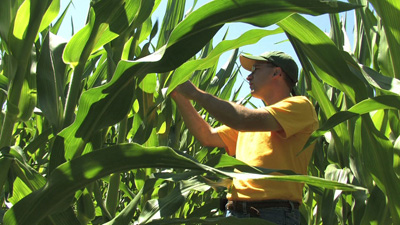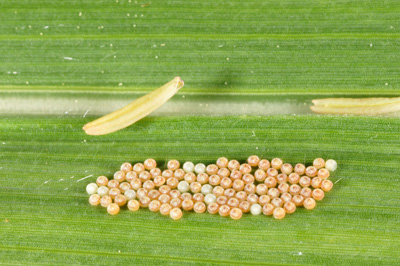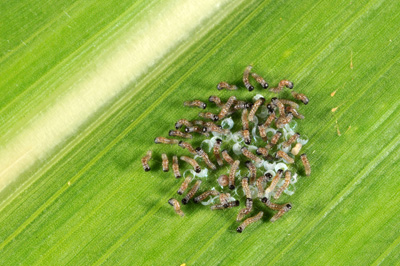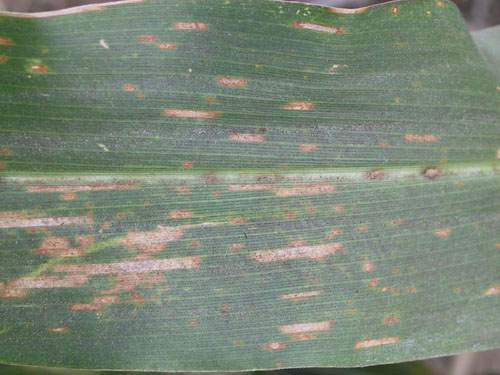- Western Bean Cutworm Flight Intensifying, Egg Hatch is Underway
- Black Light Trap Catch Report
- Western Corn Cutworm Adult Pheromone Trap Report
- Gray Leaf Spot on Corn
- VIDEO: Focus Area Prior to Foliar Fungicide Application
- VIDEO: Bacterial Blight of Soybean
Western Bean Cutworm Flight Intensifying, Egg Hatch is Underway - (Christian Krupke and John Obermeyer)
• After a slow start, moth counts starting to spike this week.
• First eggs detected, and hatching is occurring.
• Scouting for egg masses and hatched larvae should begin in high-risk areas
The western bean cutworm (WBC) trapping season continues, it looks like we are beginning to approach the peak in emergence. Not too surprising that counts are surging – our recent weather of very high temperatures will help pupae finish off development and emerge from the soil. Clear nights with light breezes (i.e. no storms) are absolutely perfect for moth flight, mate-finding and egg-laying.
We are likely entering the key period for egg-laying, as a large percentage of this year's eggs will be laid over the next 2 weeks. Use this year's trap catches (see following trap report) and recent history as your guide for prioritizing scouting areas. As you view the "Western Bean Cutworm Adult Pheromone Trap Report", notice the variability of moth captures, even within close proximity of each other. Although the relationship between trap catches and damage is not particularly strong (i.e., high trap counts does not always mean high damage), traps are a good timing mechanism and presence/absence indicator. When they spike suddenly, it's time to scout. A larger number should be scouted more urgently than a smaller one. But that's about as far as we can take trap counts in assessing damage potential. Areas/fields with damage last year will likely be at most risk this year, but damage will spread to adjacent counties to the south and east of the corn northwestern "hot zone" for WBC. As we've said during the winter, we expect more counties to be affected this year than last and more potential for damage in counties where the pest was seen previously. The good news is that we can manage this pest, either with Bt hybrids or with scouting and well-timed insecticide applications.
As a result of our own scouting and reports from various cooperators, we know eggs are present in several fields in northwestern Indiana. There will be many more deposited over the next little while, so scouting is essential in high-risk areas of the state, this zone includes most of the counties in the northern part of the state (especially northwestern counties), and sandy soil areas are particularly at risk. Pre-tassel corn is preferred by egg-laying females (the young larvae feed on pollen at first), and short hybrids seem to be a favorite as well.
Scouting is a matter of walking fields and looking for egg masses, generally laid on the top surface of the plant's upper leaves. If more than 5% of plants surveyed have egg masses, treatment is advised. Although fungicide applications are going on soon, don't feel tempted to put some insecticide in the tank without at least one scouting trip through the field beforehand. Again, consider the variable moth captures, which often correlate with variable egg laying from field to field (even within a field). If needed, early insecticide applications are better than late ones – pyrethroid insecticides will offer enough residual activity in most cases for several days of killing hatching larvae as they travel on their way into the plant's whorl or leaf axils. Once they get inside the whorl/ear of the plant they cannot be contacted with insecticides.
We expect WBC egg-laying to be the main event for the next couple of weeks of pest activity… stay tuned and keep the reports coming!
Time to scout high-risk corn for western bean cutworm egg masses
Developing egg mass next to pollen anthers
Hatching larvae eating the egg shells before moving to the whorl
![]()
Click here to see the Black Light Trap Catch Report
![]()
Click here to see the Western Bean Cutworm Adult Pheromone Trap Report
![]()
Gray Leaf Spot on Corn – (Kiersten Wise)
The recent warm, humid weather has been favorable for development of the corn disease gray leaf spot. This disease has been observed mostly on lower leaves of corn in fields, but lesions may be found on leaves right below the ear leaf in some susceptible hybrids. We recommend scouting fields now to determine the level of disease present. The fungus that causes gray leaf spot, Cercospora zeae-maydis, infects the corn plant during prolonged warm (75°F to 85°F), humid (more than 90 percent relative humidity) periods. Symptoms are commonly observed following long periods of heavy dew and overcast days.
Early gray leaf spot symptoms are observed on leaves as small, pinpoint lesions surrounded by yellow halos. At this stage, it can be hard to correctly identify the disease, but as lesions mature, they elongate into narrow, rectangular, brown to gray spots (Figure 1). Lesions on susceptible hybrids expand parallel to leaf veins and may become 1.5 to 2 inches long.
Cercospora zeae-maydis spores can cease development during low humidity periods, and then resume the infection process once humidity rises. Each lesion can produce many spores, which are splashed or blown to the upper leaves or to other plants where they can survive until conditions are favorable for infection. This cycle makes it appear that the disease is moving up the plant.
Figure 1. Gray leaf spot lesions on a corn leaf
Due to the length of the infection process, symptoms may not be noticeable for up to two weeks after infection, depending on weather conditions and hybrid susceptibility. Hot, dry weather will restrict disease development and spread.
Yield loss may depend on the number of lesions and how far up in the canopy they occur as the plant enters tasseling and pollination. If lesions have reached the ear leaf or higher during the two weeks before and after tasseling, yield loss could occur. If lesions develop on upper leaves later in the season, the economic impact will be less.
Preventative management strategies can reduce economic losses due to gray leaf spot. In-season disease management options, such as fungicides, are also available. Susceptible hybrids planted in no-till or reduced-till fields are at high risk for gray leaf spot development, but weather is the primary influence on disease development.
It is important to remember that a fungicide application is an additional cost to corn production, and growers must consider economic factors (corn market price, and fungicide application cost) and other disease factors before deciding whether to apply a fungicide for gray leaf spot management.
Research in Indiana indicates that strobilurin and strobilurin/triazole premix fungicides are most effective at preventing yield loss when applied in response to disease presence, and at the tasseling to early silking (VT-R1) growth stage. Scouting fields around V14, or just prior to tassel emergence, can help determine the level of disease pressure in a field.
Iowa State University developed guidelines to determine when a fungicide may be necessary to prevent yield loss. These thresholds and incorporate hybrid susceptibility ratings and disease levels prior to tasseling:
- Consider a fungicide application if:
The hybrid is rated as susceptible or moderately susceptible AND 50 percent of the plants in a field have disease lesions present on the third leaf below the ear leaf or higher prior to tasseling. Please see the following video for identifying the area on the plant to scout. - Consider a fungicide application if:
The hybrid is rated as moderately resistant AND 50 percent of the plants in a field have disease lesions present on the third leaf below the ear leaf or higher prior to tasseling AND additional factors or conditions that favor disease development are present (residue present, favorable weather conditions).
Scout even resistant hybrids for disease problems, but, in general, fungicide applications to these hybrids are not recommended and will not consistently result in increased yield.
The thresholds available for fungicide application decisions are not hard and fast rules. It is important to remember that gray leaf spot severity can be unpredictable in Indiana, even when factors favoring disease are present. For instance, in 2010, we had very favorable weather conditions for gray leaf spot development at tasseling/silking stage of corn development. However, the environment became very hot and dry after silking, and disease did not progress as expected. Consequently, fungicide applications were not profitable in many of our research locations. Therefore, consider threshold guidelines, cropping practices, planting date, predicted weather conditions, and economic factors when deciding whether to use a fungicide to manage gray leaf spot, and manage expectations on what type of yield response a fungicide application will provide.
VIDEO: Identifying the area of the corn plant to scout for foliar diseases
![]()
VIDEO: Bacterial Blight of Soybean
![]()
Indiana Pesticide Clean Sweep Project
![]()








